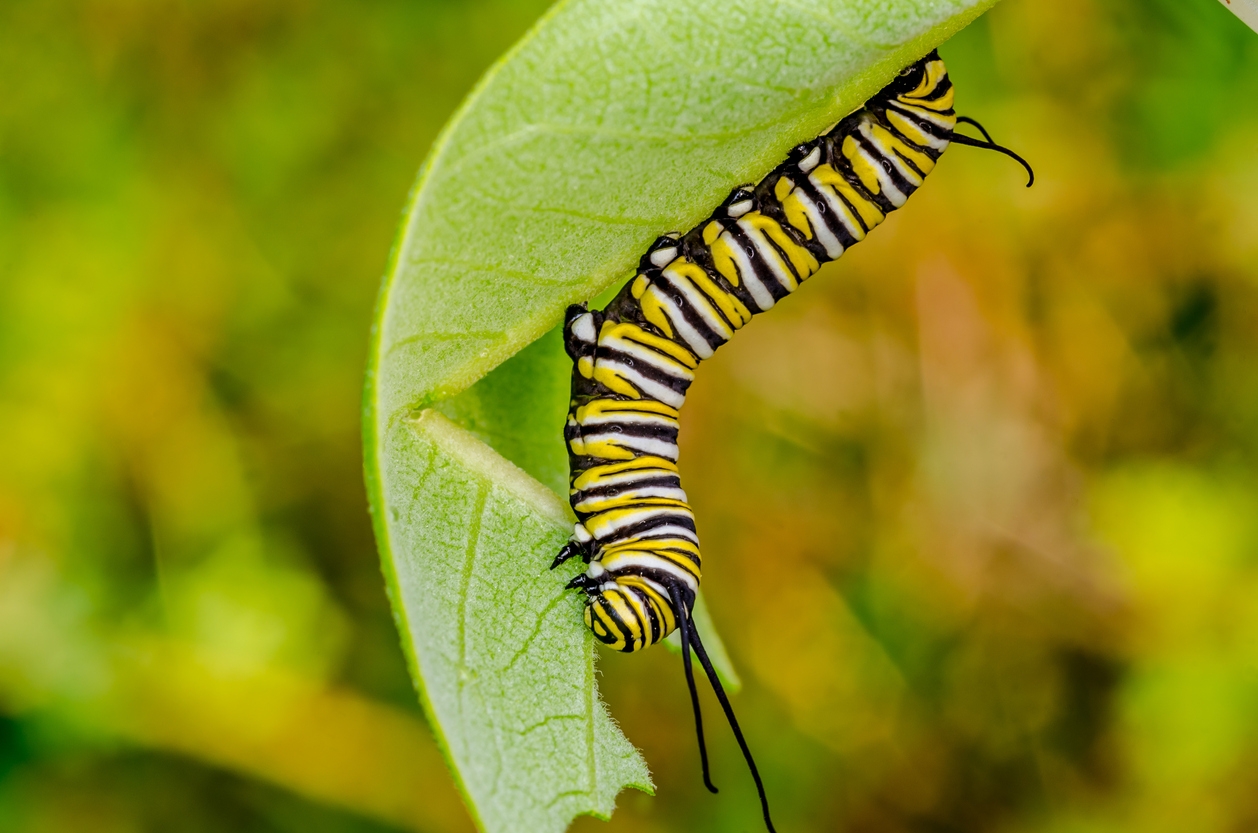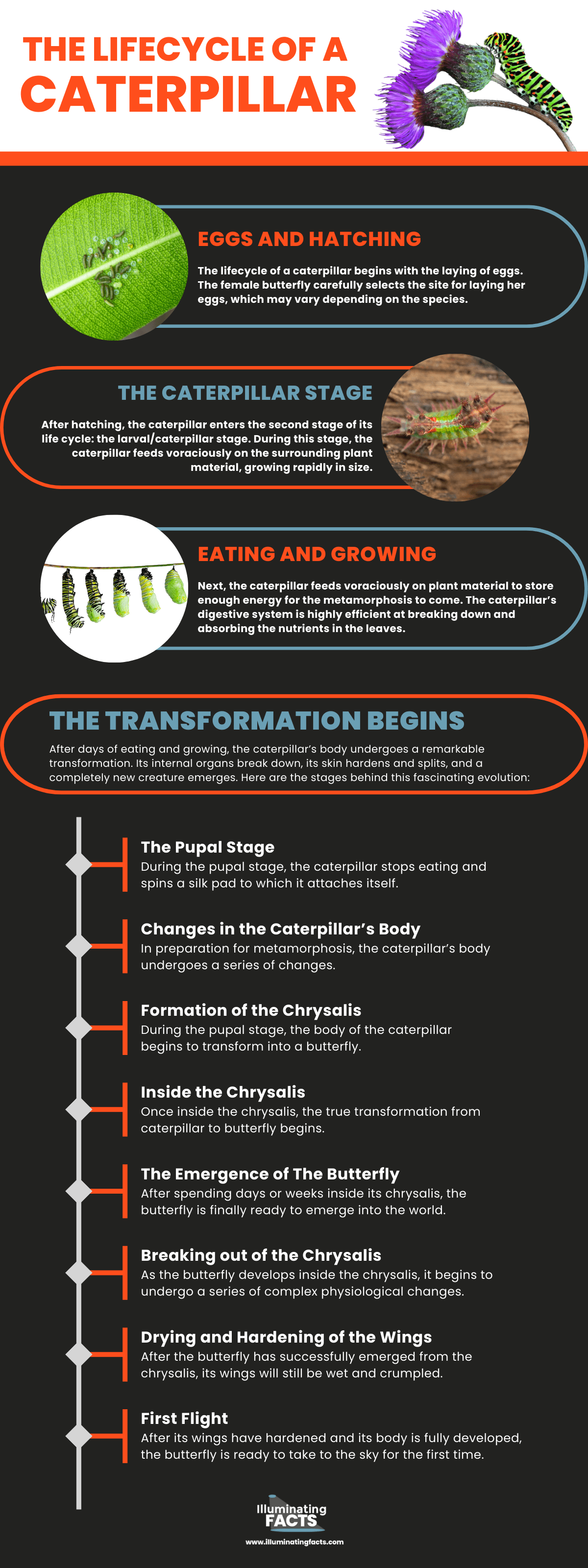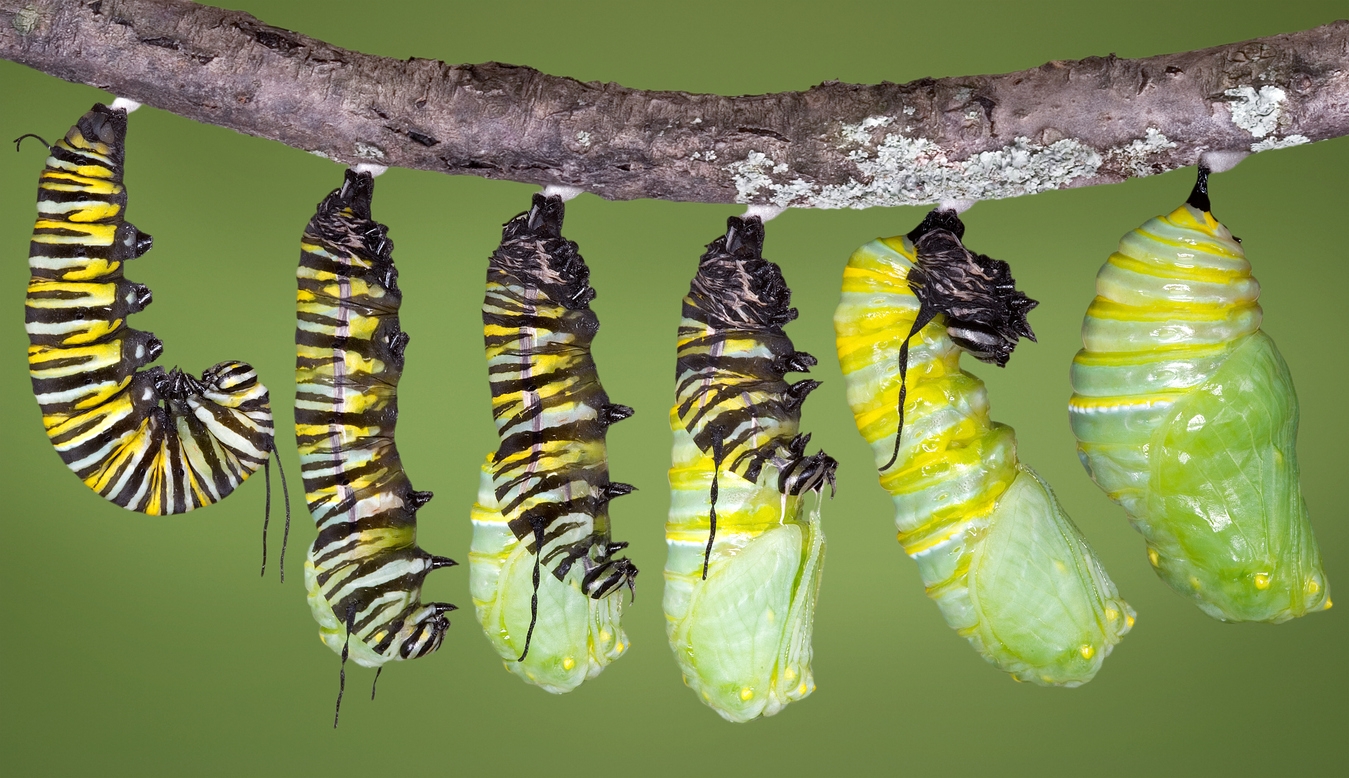Picture this: a tiny, wriggling caterpillar munching away on leaves, gradually shedding its skin, and emerging as a stunning butterfly with wings as delicate as fine lace. It’s a transformation that defies the imagination and leaves you in awe of the mysteries of nature.
This metamorphosis is nothing short of a miracle, as a creature so small and unassuming transforms into a creature of stunning beauty and grace. The journey of a caterpillar turning into a butterfly is a captivating and inspiring tale that will leave you feeling wonderstruck.
What is metamorphosis? And how exactly does a caterpillar transition into a butterfly? This article explains it all—keeps reading to uncover the process behind the magical transformation.
What is metamorphosis?
Metamorphosis is the process by which an organism undergoes a complete structural change, from one life stage to another. During metamorphosis, an organism goes through various distinct phases, each with its own unique set of characteristics and behaviors.
In the case of insects, the process starts with an egg, followed by a larval stage where the organism grows and develops, then a pupal stage where it transforms into its adult form, and finally, the emergence of an adult insect. This remarkable process is nature’s way of allowing organisms to adapt and survive in different environments, and it’s one of the most incredible examples of nature’s wonders.
Brief overview of the process of a caterpillar changing to a butterfly
The process of a caterpillar transforming into a butterfly is a remarkable example of metamorphosis. It involves a complete change in form and function, as the caterpillar undergoes a series of developmental stages, including egg, larva, pupa, and adult. During this lifecycle, the caterpillar’s body tissues are broken down and reorganized into the adult butterfly’s body plan, which is optimized for flight and reproduction. [1]
The Lifecycle of a Caterpillar
The lifecycle of a caterpillar can be categorized into three stages:
Eggs and hatching
The lifecycle of a caterpillar begins with the laying of eggs. The female butterfly carefully selects the site for laying her eggs, which may vary depending on the species. Once the eggs are laid, they are left to develop and hatch. The length of time it takes for the eggs to hatch depends on factors such as temperature and humidity. [2]
During this first stage of the lifecycle, the eggs are typically small, round, and have a hard outer layer. Inside the egg, the caterpillar begins to develop, with its body and organs taking shape. As the embryo grows, it eventually reaches a point where it is ready to hatch. At this point, the caterpillar secretes enzymes that dissolve the shell of the egg, allowing it to break free.
Once the caterpillar has hatched, it begins to feed on the plant material surrounding it, thus entering the caterpillar stage.
The caterpillar stage
After hatching, the caterpillar enters the second stage of its life cycle: the larval/caterpillar stage. During this stage, the caterpillar feeds voraciously on the surrounding plant material, growing rapidly in size. As it grows, the caterpillar molts or sheds its skin several times in a process called ecdysis.
This stage is characterized by the presence of several pairs of legs, as well as simple eyes and a mouth that is adapted for chewing. Caterpillars come in a variety of shapes and sizes, depending on the species. Some caterpillars are smooth and cylindrical, while others are covered in spines or hair-like structures called setae.
Despite the wide variety of appearances, all caterpillars share a common goal during this stage of their life cycle: to store up enough energy to complete the next stage of metamorphosis.
Eating and growing
Next, the caterpillar feeds voraciously on plant material to store enough energy for the metamorphosis to come. The caterpillar’s digestive system is highly efficient at breaking down and absorbing the nutrients in the leaves. Some species of caterpillars can consume several times their weight in plant material in a single day.
As the caterpillar grows and eats, it molts its skin repeatedly, with each new exoskeleton being larger and stronger than the previous one. [3]
Essentially, caterpillar’s sole focus is on eating and growing. Once the caterpillar has reached its full size and has stored up enough energy, it will enter the transformation phase.
The Transformation Begins
After days of eating and growing, the caterpillar’s body undergoes a remarkable transformation. Its internal organs break down, its skin hardens and splits, and a completely new creature emerges. Here are the stages behind this fascinating evolution:
The Pupal Stage
During the pupal stage, the caterpillar stops eating and spins a silk pad to which it attaches itself. Its skin then splits and is shed, revealing a chrysalis or pupa. The pupa is a non-feeding stage, during which the caterpillar’s body undergoes a complete transformation into an adult butterfly.
This transformation takes place through a process called histolysis, in which the larval tissues are broken down and reorganized into the adult structures of the butterfly. The pupa is usually motionless, but inside, the butterfly is developing rapidly.
Changes in the Caterpillar’s Body
In preparation for metamorphosis, the caterpillar’s body undergoes a series of changes. Its digestive system is broken down, and its tissues and organs are reorganized into the adult butterfly’s body plan.
The caterpillar’s nervous system is also completely restructured. This restructuring is necessary because the adult butterfly’s body is completely different from the caterpillar’s body. For example, the adult butterfly has wings, which the caterpillar does not.
Formation of the Chrysalis
During the pupal stage, the body of the caterpillar begins to transform into a butterfly. The first visible sign of this transformation is the formation of the chrysalis. The chrysalis is a protective covering that the caterpillar creates around itself using a substance called silk.
The silk comes from glands in the caterpillar’s body and hardens into a tough outer shell. The chrysalis serves as a safe space for the caterpillar to undergo the complex changes that will transform it into a butterfly. As the caterpillar pupates and the chrysalis forms, the caterpillar’s body is broken down into a kind of soup, and the cells that will form the butterfly start to form. [4]
Inside the Chrysalis
Once inside the chrysalis, the true transformation from caterpillar to butterfly begins. The cells that will form the butterfly start to multiply and differentiate, forming wings, antennae, legs, and all the other structures that make up the adult butterfly. It is a complex and amazing process, driven by a series of chemical and genetic changes that are not yet fully understood by scientists. [5]
As the metamorphosis proceeds, the old caterpillar body breaks down and the new butterfly body takes shape. Finally, when the metamorphosis is complete, the butterfly is ready to emerge from the chrysalis and take to the air.
The Emergence of The Butterfly
After spending days or weeks inside its chrysalis, the butterfly is finally ready to emerge into the world. This magical moment marks the end of its transformation and the beginning of a new life. Here’s more information on what’s involved.
Breaking out of the Chrysalis
As the butterfly develops inside the chrysalis, it begins to undergo a series of complex physiological changes. After several weeks of transformation, the chrysalis will start to become transparent, which signals the beginning of the emergence process.
At this point, the butterfly starts to break out of the chrysalis by contracting its abdominal muscles, which increases blood pressure in its head and thorax. This pressure causes the chrysalis to split open, exposing the butterfly’s head, thorax, and wings. The butterfly then uses its legs and wings to push and pull itself out of the chrysalis. [6]
Drying and Hardening of the Wings
After the butterfly has successfully emerged from the chrysalis, its wings will still be wet and crumpled. To become fully functional, the butterfly must allow its wings to dry and harden. This process can take anywhere from a few hours to a few days, depending on the species of butterfly and the environmental conditions. [7]
During this time, the butterfly will remain stationary and vulnerable, making it an easy target for predators. However, once its wings have fully expanded and hardened, the butterfly will be able to fly away and begin its new life as an adult.
First Flight
After its wings have hardened and its body is fully developed, the butterfly is ready to take to the sky for the first time. The first flight of a butterfly is a crucial moment in its life, as it marks the beginning of its search for food, shelter, and a mate. Many butterflies will stay close to the area where they emerged for the first few days, using their keen sense of smell to locate sources of nectar and other important resources.
Over time, butterflies may gradually expand their range, flying further and exploring new areas. For some species of butterflies, this is an especially perilous time. They may face a variety of threats, including predators, adverse weather conditions, and competition from other butterflies. In order to survive, they must quickly learn to navigate their environment and avoid danger. [8]
Despite these challenges, the first flight is an exhilarating experience for the butterfly. After spending weeks or even months in the chrysalis, the butterfly is finally able to stretch its wings and take to the sky, enjoying the warmth of the sun and the freedom of flight.
Conclusion
The transformation of a caterpillar into a butterfly is truly a remarkable process that showcases the marvels of nature. From the humble egg to the magnificent butterfly, the transformation that takes place is nothing short of miraculous. As we have seen, this metamorphosis is a complex process that involves several stages, each of which is critical to the ultimate success of the butterfly’s development.
To recap, here are the key things we from in this article:
- Metamorphosis is a process of complete transformation, and the life cycle of a caterpillar is a fascinating example of this phenomenon.
- The life cycle of a caterpillar consists of four stages: eggs, caterpillar stage, pupal stage, and butterfly
- During the caterpillar stage, the caterpillar eats and grows rapidly, shedding its skin multiple times
- In the pupal stage, the caterpillar forms a chrysalis and undergoes significant changes within its body as it transforms into a butterfly
- Inside the chrysalis, the caterpillar’s body breaks down and re-forms into a butterfly, which eventually emerges from the chrysalis, dries and hardens its wings, and takes its first flight.
- When it’s time for the butterfly to emerge, it breaks out of the chrysalis and undergoes a process of drying and hardening its wings
- Finally, the butterfly takes its first flight, marking the end of the metamorphosis process.
Overall, observing a caterpillar transform into a butterfly is an incredible example of transformation and growth. The process of metamorphosis is complex and involves significant changes to the caterpillar’s body, culminating in the emergence of a beautiful and unique butterfly. Whether you’re a budding naturalist or simply someone who enjoys the beauty of nature, the life cycle of a caterpillar and its transformation into a butterfly is a fascinating and inspiring story that never gets old.
Interesting facts
- Some caterpillars can eat up to 27,000 times their own body weight during their larval stage.
- Caterpillars have 12 eyes: six tiny stemmata and six simple eyes.
- During the pupal stage, the caterpillar’s body turns to a liquid mush before it is reassembled into the butterfly’s body.
- Butterflies can see UV light, which helps them navigate and find flowers that are good sources of nectar.
- A butterfly’s wings are made of two layers of protein, and the colorful patterns on their wings are created by light reflecting off of scales on their wings.
- The chrysalis that forms around the pupa can have a variety of colors and textures, from green and smooth to brown and spiky.
- When emerging from the chrysalis, a butterfly will use its legs to anchor itself and then pump fluid into its wings to help them expand and harden.
- The life cycle of a butterfly varies depending on the species, but on average, it takes about one month for a butterfly to complete its life cycle from egg to adult.
References
- Shuichi Suetani, & Malcolm Forbes. (2020). The metamorphosis: On being caterpillars and butterflies. Australian & New Zealand Journal of Psychiatry, 55(4). https://journals.sagepub.com/doi/full/10.1177/0004867420981412
- Butterfly life cycle. (n.d.). The Academy of Natural Sciences of Drexel University. https://ansp.org/exhibits/online-exhibits/butterflies/lifecycle/
- Britannica. (n.d.). Encyclopedia Britannica | Britannica. https://www.britannica.com/animal/caterpillar-insect-larva
- Molecular characterization of Vitellogenin and its receptor in Sogatella furcifera, and their function in oocyte maturation. (n.d.). Frontiers. https://doi.org/10.3389/fphys.2019.01532
- Evolution News. (2013, June 3). A new look inside the butterfly chrysalis. https://evolutionnews.org/2013/06/another_look_in/
- Research paper: Chrysalis or butterfly? Evaluating the significance and effectiveness of the IBSA dialogue forum. (2019, July 24). Biowatch South Africa. https://biowatch.org.za/download/research-paper-chrysalis-or-butterfly-evaluating-the-significance-and-effectiveness-of-the-ibsa-dialogue-forum/
- How do butterflies/moths spread their wings after emerging?(2014, August 27). Reiman Gardens, Iowa State University, Ames, Iowa, Butterfly House. https://www.reimangardens.com/butterfly/butterfliesmoths-spread-wings-emerging/
- Morphing of the butterfly!(2021, October 21). Sci-Port Discovery Center. https://sci-port.org/2021/10/19/morphing-of-the-butterfly/





